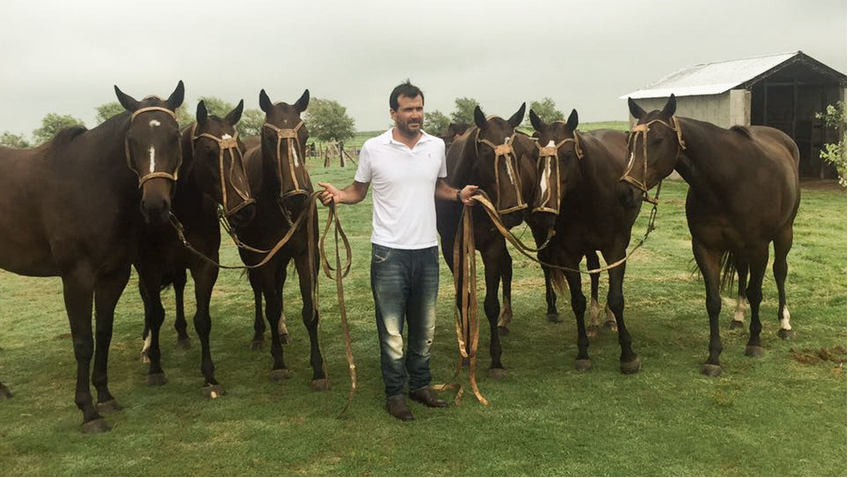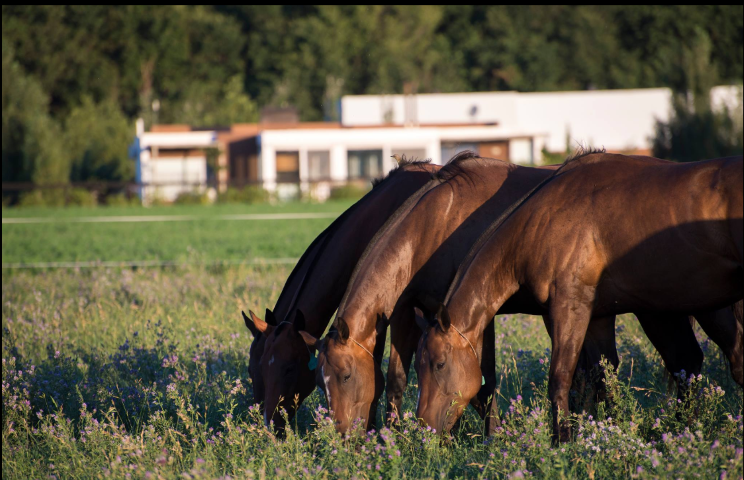La Dolfina AND Adolfo's Clones Win Polo World Championships
- Uploaded by Frank Burston La Parez Polo
- Published in Polo Ponies, Breeding, Stud Book, Bloodlines
- Hits: 29825
- Print,

Aldolpho Cambiaso and his 6 winning ponies with a difference - they are all the same.
 Alan Meeker ex-polo player's Crestview Genetics cloning world champion polo ponies for Cambiaso
Alan Meeker ex-polo player's Crestview Genetics cloning world champion polo ponies for Cambiaso
The Future is Here Cambiaso clones his favourite polo pony and rides them to World Victory Winning the Argentine Open 2016
December 2016, at the prestigious Argentine Open Polo Championships in Palermo Buenos Aires polo playing giant Adolfo Cambiaso rides six polo ponies with a difference . . . or not. Cambiaso and his team La Dolfina won the tournament taking the polo world's top honour for the 4th year in a row making him with out question the world’s best polo player, again. Yet perhaps what is even more noteworthy is that all six ponies he rode were clones of the same mare.
Polo, unlike most equine sports allows cloning, and the practise has become increasingly popular since 2013 when Cambiaso first helped his team win the same prestigious event riding a clone. This year the clones all were from the mare named Cuartetera, one of Cambiaso's favourite polo ponies. His rides for the 2016 Argentine Polo Open were called Cuartetera 01, Cuartetera 02, Cuartetera 03, Cuartetera 04, Cuartetera 05 and Cuartetera 06. Noteworthy enough? Well then the icing on the raised eyebrows for you maybe that Cuartetera 06 was a copy.
Veterinarian at Texas A&M University, Katrin Hinrichs cloned the pony Cambiaso first rode in 2013. Hinrichs states that, 'breeding a great stallion to a great mare is still the best way to make better horses'. She points out, 'cloning is a sideways move, it doesn’t improve the breed'. According to Henrich, it would be wise to keep clear in your mind two things, ”it’s difficult to separate the importance of a rider’s expertise from the contribution of a great horse. If it’s Adolfo Cambiaso, he could probably ride plow horses. Also polo players don’t necessarily want to breed better horses, they just want to play to win." Hinrichs also suggests people should remember the possibility this all could be good, “public relations.” Cambiaso has a business interest in the company based in Texas and Argentina, Crestview Genetics, that bred the cloned horses.
Polo is a sport that combines power, plasticity, technique and speed and for some has comparisons with with Formula 1. The engine of Lewis Hamilton Mercedes or Nico Rosberg Mercedes have, for example, 950 horsepower. The drivers bring their talent to drive and have all the technology behind. In fact, it is the cars that make the big difference. In polo, there are plenty of talents that do wonders with the malet, hitting a ball when they go to 60 or 70km / h. But those who mark territory are the ones below the rider, the real machines are the polo ponies. Horses of exception. Influence percentages? An 80-20% on the horse-player deal is widely accepted as about right. So how does this stack up with Hinrichs informed view?
'Though cloning itself can’t improve a line, it can offer some advantages to the original donor horse', Hinrichs says. “If you start with a genetic mix that can really do this, then with cloning you know you have the ability to make sure a filly gets the best environment and care to go forward and you have the potential for the fillies to be better than the originals.”
Alan Meeker, who founded Crestview and is based in Fort Worth, Texas, says he respects Hinrichs but disagrees with her on this point. “She has it backwards,” says Meeker, “It’s 70% to 80% the horse, and everyone, including Cambiaso, will tell you this.” A former polo player himself Meeker's interests in the oil and gas industry, allowed him the where-with-all to start experimenting in cloning horses. His Company Crestview has cloned more than 200 horses since 2009. “We’ve thrown a title wave of money at an idea we had that just so happened to work out,” says Meeker. His interest in cloning began when he developed type 1 diabetes as an adult and wanted a new pancreas. “We’ve turned the breeding industry that does equine around 180°", he says.
Meeker's company faced abundant skepticism at the start. “Every scientist that deals with epigenetics told me this would never work,” says Meeker, referring to the fact that the environment modifies gene activity and helps explain why identical twins aren’t truly identical. Critics also have asserted that clones cannot perform as well as the original horse. Cambiaso’s use of increasing numbers of clones in the same match has silenced many. In October, he first rode six clones in the Tortugas Open Tournamen. “They thought I was crazy,” he said afterwards, "and today it seems that I was not so crazy, right?"
Meeker says, 'his team has narrowed as much as humanly possible the difference between original and the clone, even making sure the barn blankets and dogs are the same colors as the ones the original donor knew'.
Crestview Genetics now is coupling cloning with traditional breeding to, 'make a better line'. Typically, breeders cannot pull more than four oocytes, or eggs, from a mare in a year, whereas stallions can provide sperm for a few hundred mares. With increasing numbers of female clones, Crestview has many more oocytes from the “same” animal to pair with stallions. “We want to show we can create a genetic improvement for breeding,” states Meeker
Ultimately, Hinrichs says, the Palermo match shows how far the technology has progressed since the early days of animal cloning, which had a lot of failure and early death. “It’s great to know that there are six clones that were born and are healthy enough to do that kind of athletic competition,” she says. “That really says something with the robustness of the cloning procedure.”
Meeker attended the Argentine Open and embraced Cambiaso after the win. “It took 7 years, but we did it, 7 years,’” Meeker remembers, “It was a very emotional match. It’s vindication and proof of concept.”
Getting good horses was always the aim, although times have changed since the Pampeana (Juancarlitos Harriott), Yarará (Horacio Heguy), Nochecita (Gastón Dorignac) or Milonga (Horacio Araya), all the great polo players of the past and all champions of Palermo, obtained the prizes in the most important tournament in the world the Argentine Open.
At the end of the eighties, the first great revolution took place: the embryonic transplant. A technique that allows service of the favorite mare with a top stallion, by extracting the embryo and implant it in a surrogate mother, which is the one that carries the pregnancy forward. Thus, it was possible that the large specimens gave offspring of youngsters and not just when they were 15 or 16 when they retired. They did not have to resign from play themselves or activity and that, in many cases, they ended up sharing games with their own daughters. For the players and breeders, it was a sporting and economic blessing. More offspring, more possibilities to multiply big horses and higher sales, or directly from embryos.
Twenty-five years later, embryonic transplantation continues. For some, it is already on the verge of saturation. But it is not what we are talking about today, in the midst of the Triple Crown Tournaments. The next step cloning is a second revolution and in Argentina it has an advance, Adolfo Cambiaso. The best polo player in the world and 12 times champion of the Agentine Open.
History of Cambiaso's link to cloning, began 10 years ago, when in the full final of the 2006 Argentine Open with La Aguada., one of his favorite ponies Aiken Cura suffered a fracture. Faced with the irreversible loss of the stallion of the breeding of Ricardo Santamarina, he asked that they remove cells, which were then frozen in two universities. Until fate crossed with Texan mogul Alan Meeker.
Cambiaso, 41, related to Meeker and together they took the first steps in the cloning of great polo ponies. Obviously, the first was Aiken Cura. This was done in the United States. Then came the Cuarteteras, copies of his favorite mare and more, surpassing even in fame the remembered Hummingbird, that marked a time when Adolfito played for Ellerstina.
"The cloned specimen is a photocopy, genetically and phenotypically. The transplant can have some physical difference," explains Máximo Aguirre Paz, an experienced veterinarian from the times of Coronel Suárez and the Indians Chapaleufú. "Genetically, with cloning you maintain the quality.You can even recover lines, such as a castrated male that revives in its natural state. What I do not think you can clone is all that comes after weaning, dressage, fitness There we entered another more diffuse terrain, "says Aguirre Paz.
When Cambiaso began to turn to cloning, without abandoning the embryo transplantation, he was looked at sideways in the political environment. Few believed, for example, that he could recycle Cuartetera, by his own expression, "the best mare he played in his life", when she had already withdrawn from high competition. The belief was that while he could pull out ten Cuarteteras, none of the copies would have the quality of the original. Nothing guaranteed success.
Together with Meeker and Argentine businessman Ernesto Gutiérrez (former president of Aeropuertos Argentina 2000), Cambiaso founded Crest View Genetics in Luján, one of the most important cloning centers in Argentina. Under the direction of the veterinarian Adrian Mutto, many future dreams are cemented there. An issue that started gaining more prominence a few months ago, when the emblem of La Dolfina used 6 of the 7 clones he obtained from the Cuartetera in the final of the Argentine Open against Ellerstina. Even one of them, clone 06, was a double!
